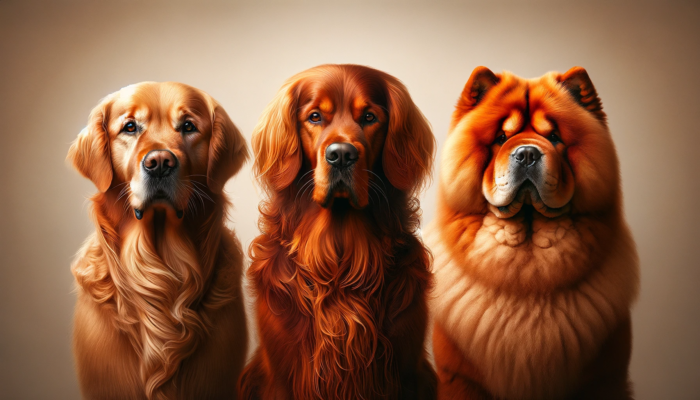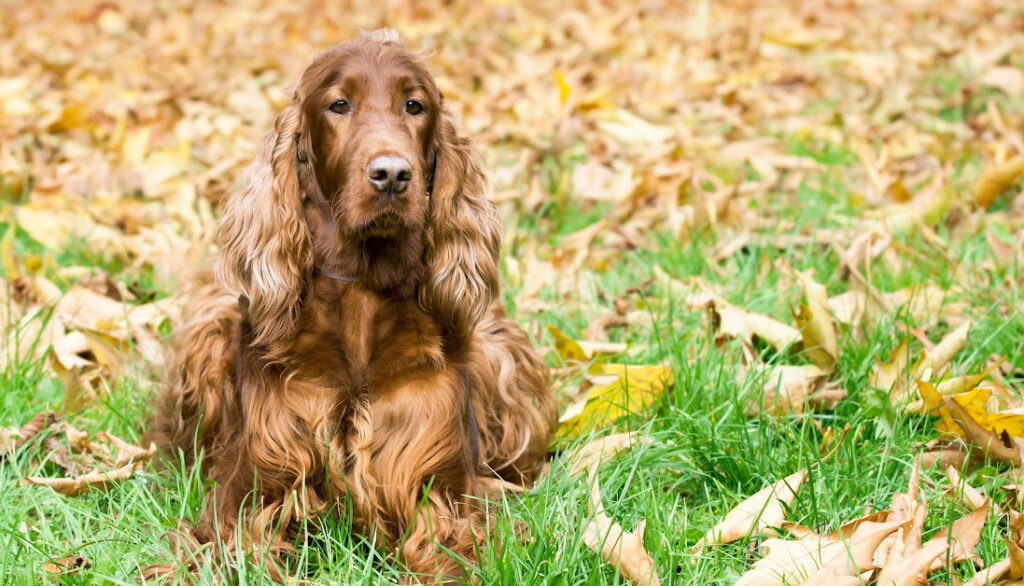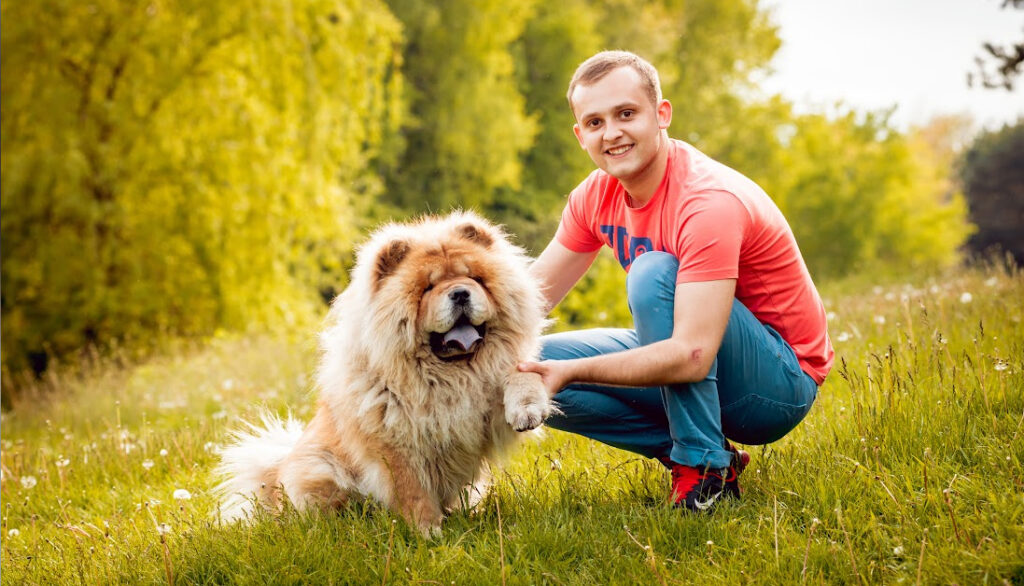Welcome to the world of orange dog breeds! This radiant group of canines has a lot to offer, from their striking aesthetics to their unique temperaments. Understanding different dog breeds helps us appreciate their individuality and can aid in finding the perfect pet that fits into our lifestyle.

Dogs come in a riotous rainbow of colors, but have you ever wondered why? It’s all down to genetics. The color of a dog’s coat is determined by complex genetic interactions. The genes responsible for a dog’s coat color can be dominant or recessive, and many other factors can modify the resultant color. So, an orange-colored dog inherits this color from its parents!
There’s a variety of popular orange dog breeds you might consider. For instance, the beloved Golden Retriever, with its luscious golden coat and friendly demeanor, is a favorite among families. The Irish Setter, known for its fiery red-orange coat, is renowned for its energy and intelligence. Then there’s the Nova Scotia Duck Tolling Retriever, a smaller, fox-like breed that sports a beautiful reddish-orange coat. Each of these breeds has its unique characteristics, which we’ll delve into to help you understand them better.
However, owning a dog, regardless of its breed or color, comes with responsibility. These orange dog breeds, like all dogs, have specific health considerations that need attention. They also require regular care and maintenance to ensure they live healthy, happy lives.
Choosing the right dog breed for your home can be a challenging task, especially when you’re drawn to such vibrant canines! But don’t worry, we’ll guide you through the process, highlighting the factors to consider and providing tips for first-time owners. So, if you’re ready to brighten up your home with a lively orange dog, let’s dive into this colorful canine world!

Understanding the Color Genetics in Dogs
Have you ever wondered how your favorite orange dog breeds, like the fiery Irish Setter or the radiant Golden Retriever, get their distinctive fur colors? Well, fasten your seatbelts because we’re about to dive into the fascinating world of canine color genetics!
How Dogs Get Their Color
Let’s start with the basics. The color of a dog’s coat comes mainly from two pigments – eumelanin (black) and pheomelanin (red or yellow). The shade of the coat color that we see, whether it’s the deep gold of a Nova Scotia Duck Tolling Retriever or the light fawn of a Basenji, depends on how these pigments are distributed, the quantity produced, and the way they’re modified by various genes.
For instance, an orange coat in dogs is essentially a shade of red. It’s the result of pheomelanin pigment dominating with minimal influence from eumelanin. The intensity of the orange color can vary from light cream to deep, rich red, depending entirely on how the genes play with the pigments. Isn’t that simply amazing?
The Role of Genetics in Determining Dog Colors
When it comes to the role of genetics in deciding the color of dogs, it’s all about the combination of genes inherited from the parents. Every dog receives one set of color genes from its mother and one from its father. The interaction between these genes decides the final color and pattern of the dog’s coat.
For example, the gene that causes the orange color in dogs is recessive. This means that a dog needs to inherit the orange gene from both parents to sport this vibrant color. If it inherits a dominant color gene from one parent, say for a black coat, it will end up with a black coat, despite the orange gene from the other parent. The orange gene will be carried forward in its genetic code, and it can potentially pass it to its offspring.
Moreover, the shade of orange can also be influenced by other genes. Modifier genes can lighten or darken the base color, resulting in a wide array of shades from light cream to fiery red. Isn’t it fascinating how the complex interplay of genes results in the beautiful and diverse fur colors we see in our beloved canine friends?
Now, understanding how these color genetics work might seem like a fun trivia to impress your friends at the next gathering. But the truth is, it’s much more important than that. Knowing about your dog’s color genetics can help you understand their breed better, predict the colors of any potential offspring, and even help identify potential health risks associated with certain color genes. So, the next time you look at your vibrant orange dog breed, remember, it’s not just a pretty coat, but a testament to the marvel that is canine color genetics!
List of Popular Orange Dog Breeds
There’s a myriad of dog breeds that boast beautiful, vibrant orange coats. Let’s dive into some of the most popular ones and explore their unique characteristics. Remember, understanding the unique traits of different breeds can help you make an informed decision if you’re considering adding an orange-furred friend to your family.
Golden Retriever
The Golden Retriever is probably one of the first breeds that come to mind when you think of orange dog breeds. Known for their friendly and tolerant attitudes, these pups are extremely obedient and make excellent family pets. They have a dense, water-repellent outer coat with a heavy undercoat. Some coats are wavy, some straight, with color ranging from a light golden to a deep, honey-colored orange.
Irish Setter
A stunning breed with a striking deep orange or mahogany coat, the Irish Setter is often associated with nobility and luxury. They are active, aristocratic bird dogs who adore their humans and require regular interaction and exercise. Their silky coat requires regular grooming to maintain its glossy appeal.
Nova Scotia Duck Tolling Retriever
The Nova Scotia Duck Tolling Retriever, or “Toller” for short, sports a gorgeous reddish-orange coat. These dogs are the smallest of the retrievers and were initially bred in the early 19th century to attract, retrieve, and toll waterfowl. Tollers are known for their high energy levels, agility, and intelligence.
Chow Chow
Originating from China, Chow Chows are one of the oldest and most distinctive breeds. Their lion-like appearance and beautiful deep orange coat make them a standout. They have a unique blue-black tongue, almost scowling expression, and somewhat aloof nature, which adds to their charm.
Shiba Inu
The Shiba Inu is a small, compact, and agile dog native to Japan. They are known for their spirited personality, small upright ears, and beautiful orange-red coats. Shiba Inus are alert, active dogs that can be a little reserved, but are extremely loyal to their families.
Brittany Spaniel
Brittany Spaniels are medium-sized dogs known for their versatility as family pets and field dogs. They have a dense flat or wavy coat that comes in different shades of orange and white patterns. Known for their agility and obedience, Brittanys are intelligent and enthusiastic, making them great companions for active families.
Each of these orange dog breeds has a unique set of traits, temperament, and care requirements. Whether you’re looking for a loyal companion, family pet, or a sporting dog, there’s an orange dog breed that’s sure to be a perfect match for you.

Detailed Profile: Golden Retriever
Breed History and Origin
The Golden Retriever, one of the most recognizable orange dog breeds, originated in the Scottish Highlands during the mid-19th century. These lovable canines were initially bred by a man named Dudley Marjoribanks (also known as Lord Tweedmouth) who desired a dog that was adept at retrieving game from both land and water.
Lord Tweedmouth crossed a Yellow Retriever with a now-extinct breed known as the Tweed Water Spaniel, producing a litter that later included a dog named Nous, widely considered the ‘founding father’ of Golden Retrievers. Other breeds like the Irish Setter and Bloodhound were also introduced into the lineage, ultimately resulting in the Golden Retriever we know and love today.
Golden Retrievers were officially recognized by The Kennel Club in England in 1911 and later by the American Kennel Club in 1932. Today, they rank as the third most popular dog breed in the United States.
Care and Maintenance Tips
Golden Retrievers are an active breed requiring regular physical and mental stimulation. Regular walks, playtime, and puzzle toys can help keep them engaged and prevent destructive behaviors.
Their thick, water-resistant coats, ranging from light to dark gold, require regular grooming. Here are some grooming tips:
- Brushing: Golden Retrievers should be brushed at least once a week to prevent matting and keep their coat healthy. During shedding seasons (spring and fall), daily brushing may be necessary.
- Bathing: Bath your Golden Retriever every six to eight weeks, or more frequently if they get dirty from outdoor play.
- Nail Trimming: Regular nail trimming is essential as long nails can make walking uncomfortable for your dog.
As for their diet, Golden Retrievers do well on high-quality dry kibble, but they’re also known for their love of food and can be prone to obesity. Therefore, portion control and limited treats are important.
Golden Retrievers are generally healthy, but like all breeds, they’re prone to certain health conditions. Not all Goldens will get any or all of these diseases, but it’s essential to be aware of them if you’re considering this breed. These may include hip dysplasia, cataracts, and certain types of cancer.
Overall, Golden Retrievers make wonderful family pets due to their friendly and tolerant attitudes. They are also excellent working dogs, excelling in roles such as guide dogs for the blind, hearing dogs for the deaf, and search and rescue roles. Their intelligence, eagerness to please, and love for people make them one of the most beloved orange dog breeds around the world.

Detailed Profile: Irish Setter
When it comes to orange dog breeds, the Irish Setter is a standout with its striking, glossy, and deep red or mahogany coat. This breed is not just known for its good looks but also for its friendly and outgoing nature, making it a favorite among dog lovers.
Breed History and Origin
The Irish Setter, also known as the Red Setter, originated in Ireland in the 18th century. This breed was initially developed for bird hunting, thanks to their excellent sense of smell and high energy levels. The breed’s ancestors include the English Setter, Gordon Setter, and spaniel-type dogs. Over time, the Irish Setter has evolved from a working dog to a beloved family pet and show dog.
While the breed standard calls for a deep red or mahogany color, early Irish Setters were actually red and white. The solid red color we commonly associate with the breed today became more popular in the 19th century.
Care and Maintenance Tips
Caring for an Irish Setter requires a commitment to regular exercise and grooming. Here are some tips to keep your Irish Setter healthy and happy:
- Exercise: Irish Setters are energetic dogs that require daily exercise to keep them physically and mentally stimulated. This could include long walks, runs, or play sessions in a secure area.
- Grooming: Their beautiful coat needs regular brushing to prevent matting and tangling. They are moderate shedders, so expect some hair around your home.
- Diet: They need a balanced diet to maintain their health. Always opt for high-quality dog food and avoid overfeeding to prevent obesity.
- Training: Irish Setters are intelligent but can be a bit stubborn. Consistent, positive reinforcement training methods work best with this breed.
- Healthcare: Regular vet check-ups are essential to monitor for common health issues in the breed, such as hip dysplasia, progressive retinal atrophy, and epilepsy.
In addition to these tips, it’s important to remember that every Irish Setter is unique. Spend time getting to know your dog’s personality and preferences, and you’ll both enjoy a rewarding relationship.
Choosing an orange dog breed like the Irish Setter can bring a lot of joy and vibrancy into your home. Their friendly nature, intelligence, and stunning good looks make them a fantastic choice for active families.

Detailed Profile: Nova Scotia Duck Tolling Retriever
Among the vibrant orange dog breeds, the Nova Scotia Duck Tolling Retriever, often simply referred to as a ‘Toller’, holds a special place. Known for their fiery orange and red coats, these medium-sized dogs are not only eye-catching but also highly intelligent and energetic.
Breed History and Origin
The Nova Scotia Duck Tolling Retriever was originally bred in the early 19th century in Nova Scotia, Canada, for hunting. The breed’s unique name stems from its primary function: luring or “tolling” ducks into range for hunters. Their vibrant orange coat, agility, and playful nature were used to attract curious waterfowl, making them invaluable companions for hunters.
Tollers are a mix of retrievers, spaniels, and setters, combining the best traits of these breeds to create an energetic, intelligent, and versatile hunting dog. Despite their long history, they were not officially recognized by the American Kennel Club until 2003.
Care and Maintenance Tips
Caring for a Toller requires understanding their energetic and intelligent nature. Here are a few tips for potential Toller parents:
- Exercise: Tollers are active dogs that require plenty of exercise. They love to play, run, and swim. Regular physical and mental stimulation is essential to keep them happy and healthy. Agility training, dog sports, or regular games of fetch are great ways to keep them engaged.
- Grooming: Their beautiful orange coat is water-repellent and requires regular grooming to keep it looking its best. Brushing once or twice a week is usually enough, but more frequent grooming may be needed during their semi-annual shedding seasons.
- Diet: A balanced diet is important for this active breed. High-quality dog food, whether commercially manufactured or home-prepared, should be appropriate to the dog’s age (puppy, adult, or senior).
- Training: Tollers are intelligent and eager to please, making them relatively easy to train. However, their training should be consistent and use positive reinforcement techniques.
Like any breed, Nova Scotia Duck Tolling Retrievers have their unique traits and requirements. But with consistent care, love, and attention, they can make a wonderful addition to your family. Their vibrant orange coat and playful demeanor can certainly brighten up your home!

Health Considerations for Orange Dog Breeds
When it comes to owning **orange dog breeds**, it’s essential to understand the potential health risks and considerations they may face. These vibrant, beautiful canines are a joy to have around, but just like any other pet, they have specific health needs and concerns that should be addressed to ensure they lead a healthy, happy life.
Common Health Issues
Many orange dog breeds, such as the Golden Retriever, Irish Setter, and Nova Scotia Duck Tolling Retriever, are predisposed to certain health conditions. Here are a few health issues common among these breeds:
- Hip Dysplasia: This is a common condition among large breeds. It occurs when the hip joint doesn’t fit into the hip socket properly, causing discomfort and limping.
- Progressive Retinal Atrophy (PRA): PRA is an eye condition that gradually deteriorates the retina, which can eventually lead to blindness.
- Hypothyroidism: This is a condition where the thyroid gland does not produce enough thyroid hormone, leading to weight gain, lethargy, and potential skin and hair problems.
- Ear Infections: Due to their drop-ear breeds, these dogs are more susceptible to ear infections. Regular ear cleaning can help prevent this.
Remember, these are potential health risks, not guarantees. Regular veterinary check-ups and a healthy lifestyle can significantly reduce the chances of these issues appearing.
Preventive Measures and Treatments
Proactive care is the key to maintaining your furry friend’s health. Here are a few preventive measures and treatments for the health issues mentioned above:
- Regular Vet Visits: Regular check-ups can help detect and address potential health issues before they become severe.
- Balanced Diet: A balanced, nutritious diet can reduce the chances of many health issues, including hypothyroidism and obesity.
- Regular Exercise: Regular physical activity will help keep your pet fit and active, reducing the risk of obesity and related complications.
- Grooming: Regular grooming, including brushing and ear cleaning, can help prevent skin issues and ear infections.
If your pet is diagnosed with any health condition, it’s crucial to follow your vet’s advice and treatment plan. Depending on the condition, this may include medication, surgery, special diets, or lifestyle changes.
The love and companionship that **orange dog breeds** provide are well worth the care that goes into their wellbeing. Being aware of potential health issues and knowing how to prevent and treat them can help ensure your canine companion stays by your side, healthy and happy, for many years to come.
Choosing the Right Orange Dog Breed for Your Home
Choosing the right dog breed can be a difficult task, especially when there are so many wonderful orange dog breeds to choose from. A dog is a long-term commitment and you want to ensure that your new furry friend fits well with your lifestyle. You also need to consider their health, temperament, and care needs. Here are some factors you should consider and tips for first-time owners.
Factors to Consider
When deciding which orange dog breed is right for you, consider the following:
- Size: Consider how much space you have at home. Larger breeds like the Golden Retriever or the Irish Setter need more space to move around. If you live in an apartment, a smaller breed like the Nova Scotia Duck Tolling Retriever might be a better fit.
- Temperament: Some breeds are more active and need more exercise than others. If you’re an active person, a Golden Retriever or an Irish Setter might be a good match. If you prefer a quieter lifestyle, a breed with a more relaxed temperament might be more suitable.
- Health Issues: Some orange dog breeds are prone to certain health issues. It’s important to know what these are ahead of time so you can be prepared for potential vet costs.
- Care and Maintenance: All dogs require regular grooming, but some breeds need more than others. For example, Irish Setters have long, silky coats that require regular brushing to prevent matting.
Tips for First-Time Owners
If you’re a first-time dog owner, here are some tips that might help:
- Do your research: Before bringing home a new dog, make sure you know as much as possible about their breed. This can help you prepare for their needs and give them the best care possible.
- Prepare your home: Make sure your home is safe for your new dog. This might include removing toxic plants, securing loose wires, and setting up a designated area for your dog.
- Consider adoption: There are many wonderful orange dog breeds in shelters waiting for their forever homes. Consider adopting instead of buying from a breeder.
Choosing the right dog breed is a big decision, but when you do your research and consider your lifestyle, you can find the perfect orange dog breed to brighten up your life. Remember that every dog, regardless of breed, is unique and will bring its own special joy to your home. So take your time, consider all the options, and prepare for the arrival of your new furry friend. After all, the love and companionship of a dog is worth every moment you spend together. Whether you choose a Golden Retriever, an Irish Setter, or a Nova Scotia Duck Tolling Retriever, your home will surely be filled with the vibrant spirit that these orange dog breeds bring. Happy dog parenting!
Frequently Asked Questions
Q1: What are some popular orange dog breeds?
A: Some popular orange dog breeds include the Golden Retriever, Nova Scotia Duck Tolling Retriever, and the Chow Chow.
Q2: Are orange dogs more prone to any specific health issues?
A: The health issues in dogs are generally breed-specific and not color-specific. However, it’s always a good idea to research the common health issues of the specific breed you are interested in.
Q3: Does the color of a dog’s coat affect its behavior or personality?
A: No, the color of a dog’s coat does not have any impact on its behavior or personality. These traits are determined by a combination of genetics, upbringing, and training.
Q4: How can I maintain the vibrant color of my orange dog’s coat?
A: Regular grooming and a balanced diet can help maintain the vibrant color of your orange dog’s coat. Some dog foods are specifically formulated to enhance coat color and shine.
Q5: Are orange dogs rare?
A: The rarity of orange dogs depends on the breed. Some breeds, like the Golden Retriever, are quite common, while others, like the Nova Scotia Duck Tolling Retriever, are less common.
Dr. Candy, a holistic veterinarian and certified raw dog food nutrition specialist, graduated from Oklahoma State University in 2009 with a DVM and has since specialized in companion animal nutrition, advocating for species-specific diets. With a background in wildlife rehabilitation and oil spill response, she combines holistic health and conventional medicine in her unique approach to treating chronic diseases, allergies, and autoimmune conditions in pets. As the owner of a veterinary practice in Colorado and an author, Dr. Candy is dedicated to educating pet parents and improving the health and happiness of animals.




